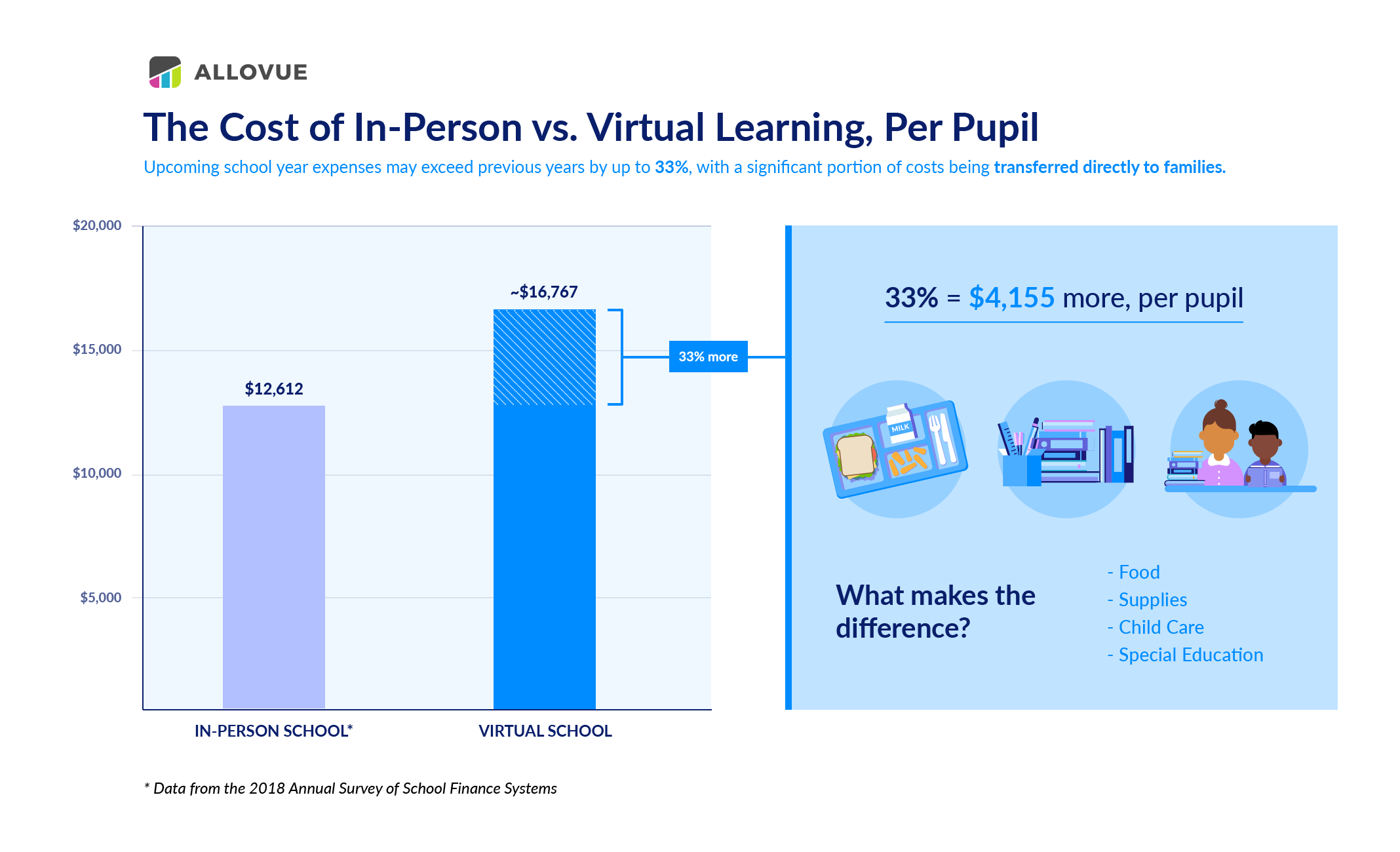Is virtual school really cheaper? Are school districts saving money with remote learning? What will full recovery and reopening really cost? In this three-part series, we’ll explore some of the hidden costs of COVID-19 for families and school districts as they navigate remote, hybrid, and reopening for in-person instruction.
As K-12 school districts across the country have rolled out their plans for virtual and hybrid instruction this Fall, the announcements have been accompanied by commentary positing that virtual schooling is cheaper—and if that’s the case, could this be a pathway to reducing education spending long-term? On social media, parents have questioned whether they can get a tax refund this year for virtual education programs on the parallel thesis that digital schooling is cheaper and districts now have piles of unspent funding to refund to parents or repurpose.
A variety of virtual charter schools, microschools, and ad-hoc analyses put the cost of virtual charter schools somewhere between $5,000-$6,000 per pupil—significantly lower than the $12,612 per pupil reported in the 2018 Annual Survey of School Finance Systems. At a glance, this cost discrepancy makes sense: virtual school eliminates huge costs associated with in-person instruction related to development and maintenance of physical facilities, transportation to and from school, and the inherent economies of scale for addressing a virtual class—instructors are quite literally no longer bound by the constraints of time, space, and proximity. So what’s the catch?
Hidden Cost: Child Care
The main problem with comparing the cost of virtual instruction to in-person school instruction is that the costs are not an apples-to-apples comparison. With virtual instruction, many of the costs are quietly decentralized and transferred to individual families/households; chief among these hidden costs: child care. When students go to a physical public school, in addition to receiving an education, families are receiving 6-8 hours per day of free childcare. When students attend school virtually, the cost of child care is immediately transferred to the family.
Only 18% of parents stay-at-home, which means the other 82% of parents are now on the hook for at-home child care and supervision while they either go to work or work from home. The average cost of child care in the US ranges from $9,000-$9,600 annually per child, although it varies significantly across cities. Even if you hired a babysitter for the $7.25 minimum wage, it would cost over $9,000 for a school year. This is by far the most significant cost that also benefits the most from economies of scale and exactly what is prompting families with financial means to pool resources for “pods” with other families. Anyway you slice it, this is a massive expense that is transferred to family budgets with virtual schooling.
HIDDEN COST | CHILD CARE
Average school year cost: $9,000-9,600* per student
*Why am I including all children and not amortizing cost across the students without a stay-at-home parent? Because stay-at-home parenting is not free—there is an opportunity cost to the household in the form of foregone wages. Furthermore, the majority of stay-at-home parents are women and our society has a habit of undervaluing and/or discounting women’s labor. Median 2020 personal income averages nearly $1000/week or about $50,000 annualized. Unless the family has 5 children or lives in an area where the cost of child care exceeds the parent’s earning potential, this is a net economic loss. A total cost analysis would include the foregone wages of all stay at-home-parents; for simplicity, I am using the average per-child cost of child care.
Hidden Cost: Supplies and Utilities
Although many schools in the US struggle to come up with resources to fully equip classrooms each Fall, for the most part, students can expect that schools will provide them with the necessary curriculum, books, and technology required to complete their classwork. Newly popular homeschool and microschool models like Prenda School offer access to their software resources for $100/child/month but “You will not receive devices for your students or physical materials.”
Expenses for devices, supplies, and curricular materials quickly add up to hundreds or thousands of dollars per year that families are now responsible for and they will have to pay full market-rate for these products, whereas school districts can benefit from lower unit rates by purchasing items at bulk-rates. Another huge cost that shifts to families to facilities remote instruction: Internet. Nationally it is estimated that 14% of school-age children do not have Internet access at home; in cities like Baltimore with concentrated areas of poverty, it is estimated that 40% of households do not have Internet access at home. For high-speed Internet that would support video-conferencing and streaming of educational content, the cost ranges from $60-100/month.
HIDDEN COST | SUPPLIES AND UTILITIES
Average school year cost: $2,000-4,000* per student for devices, curriculum, supplies, and materials; $600-1000 for Internet
*This cost-breakdown assumes a decentralized household instructional program where families either enroll in large-scale virtual schools or micro-school networks, or homeschool with parents driving instructional design. Part II will look at costs associated with district-organized remote learning with a traditional teaching force.
Hidden Cost: Food
The USDA estimates that 1 in 6 children, or 13 million children, are food insecure; these children rely on school meal programs for proper nutrition and access to food. This is critical to a student’s education because “inadequate nutrition can permanently alter children’s brain architecture and stunt their intellectual capacity, affecting children’s learning, social interaction and productivity.” 22 million children benefit from the National School Lunch Program and 12 million children benefit from the School Breakfast Program where nutritious meals are provided for a total of ~$4 per day for both meals. Meanwhile, the cost of preparing meals at home is ~$3 per meal, or $6 for breakfast and lunch (which does not include the time cost of shopping for groceries and preparing the meals) all of which is shifted to families.
HIDDEN COST | FOOD
Annual school year cost: $1,080 per student
Hidden Cost: Special Education
Nearly all of the arguments and analyses I’ve seen for the relative cost-effectiveness of virtual education leave out a costly category of free and public education: special education. 12.6% of students qualify for special education services under the Individuals with Disabilities Education Act (IDEA). Virtual schools’ record with serving special education students is murky—38 states don’t offer any clear guidance on who should be providing special education services in virtual/online schools.
The average cost of educating a child with special needs is estimated to be 2.3 to 2.5 times that of a child without special needs; the education costs of students with severe disabilities can cost 10 times as much. In remote programs, services would be required to write and implement Individualized Education Plans (IEPs) as well as potentially providing physical or occupational therapy services. The last study of special education spending put the marginal cost of special education at $5,918 per pupil, although this study is already 20 years old. A basic adjustment for inflation puts that marginal cost at $8,630 in 2020.
HIDDEN COST | SPECIAL EDUCATION
Annual school year cost: $8,630 per student qualifying for special education services; $1,087 amortized across all 50.7 million students.
Let’s stop here and look at the sum of these cost:
- Child care: $9000-9600
- Supplies and utilities: $2600-$5000
- Food: $1080
- Special education: $1087
Sum: $13,767 (9% more) -$16,767 (33% more)
Figure 1: The Cost of In-Person vs. Virtual Learning, Per Pupil
Upcoming school year expenses may exceed previous years by up to 33%, with a significant portion of costs being transferred directly to families.
Just covering the absolute basics, we’ve already exceeded the 2018 per pupil expenditure by 9-33% with a significant portion of costs being transferred directly to parents. But of course, this is far from a complete list of services that schools provide. This tally doesn’t yet account for counselors, social workers, nurses, librarians, physical education, art and music, highly certified teachers with subject matter expertise, field trips, athletics, theatre, after school clubs, parent engagement—not to mention administrative stuff like insurance, reporting, and assessments.
Hidden Cost: Effectiveness
Fiscal cost is one component, but the cost of quality or effectiveness is another important consideration. In a 2019 report on US Virtual Schools from the National Education Policy Center, fewer than half of virtual schools (48.5%) produced “acceptable” state performance ratings; for-profit virtual schools had the worst performance with just 29.8% receiving an “acceptable” rating. Additionally, the on-time graduation rate for virtual school students was just 50% compared to the national average of 84%. It is hard to put a price on effectiveness, but the evidence is clear that the current public education model for delivering education is more cost effective than virtual schooling today. When the costs of child care, supplies and utilities, food, and special education are added to the cost of virtual instruction, the total cost of virtual schooling is higher than traditional public schools while being significantly less effective—and that assumes there are no economies of scales currently realized by traditional schools and districts.
In Part II, we’ll look at the financial implications of school districts going fully remote or hybrid this Fall.
This article is Part 1 of our three-part series, The Cost of COVID-19 for Schools & Families, which examines the hidden costs of COVID-19 on families and school districts.

ABOUT THE AUTHOR
Jess Gartner is the founder and CEO of Allovue, where edtech meets fintech - #edfintech! Allovue was founded by educators, for educators. We combine powerful financial technology with education data, giving administrators the power to connect spending to student achievement. Jess has been featured as one of Forbes Magazine’s 30 Under 30 in Education (2015, 2016 All-Star), The Baltimore Sun’s Women to Watch (2013), and Baltimore Magazine’s 40 Under 40 (2013). In 2014, she was recognized as the Maryland Smart CEO Innovator of the Year in the Emerging Business category. Before founding Allovue, Jess studied education policy at the University of Pennsylvania and taught in schools around the world, including Thailand, South Africa, Philadelphia, and Baltimore. She taught middle school humanities in Baltimore City and received her M.A. in teaching from Johns Hopkins University.



